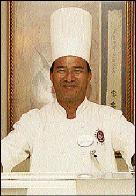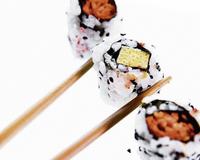Saturday Food: Easy-peasy Japanesey - Sayonara to fears about oriental dining
Published: Saturday | January 17, 2009


Sushi Chef Santa B. Thapa has been preparing Japanese cuisine for 19 years.
JAMAICANS fascinated with chopsticks occasionally stop by to dine at a Japanese restaurant. Japan, of course, is highly noted for its refined etiquette, and the attendants are highly mannerable.
Sayonara to fears about oriental dining
Nepal-born Santa B. Thapa has been preparing Japanese meals for 19 years and shares tips on dining Japanese. For the last five months, he has been the chef at The Munasan, the Japanese restaurant at the Grand Lido Negril Resort and Spa. Before that, he worked for many years in Dubai, Bahrain, and the Lebanese Meridian before emigrating to the Caribbean almost four years ago.
According to Thapa, reservations should ideally made before dining at Japanese restaurants. However, he adds that waiting guests are treated to complimentary tea or traditional Japanese sake (pronounced sah-KEh), a rice wine.
At The Munasan, you won't see carpeted floors, as in other Japanese restaurants, but guests are still expected to remove their shoes before entering. On entering, you will be greeted with 'irasshaimase' - welcome. You are taken immediately to the typical low tables or traditional tables in more modern environments.
Low tables are usually bare, except for a table mat, but surrounded by cushions for seating. As guests are seated, a finger bowl with hot water and lemon for dipping, and a small handkerchief/towel, are placed for their use.
Chopsticks follow with ceramic cups, sometimes accompanied by a menu. Throughout the meal, you will be served water or tea.

At The Munasan, guests are treated to wine or sake if requested.
Japanese meals usually consist of a bowl of rice, miso soup (suimono) and two or three side dishes. The grander the meal, the more side dishes available. If you do have many side dishes, please remember to eat them in rotating order, alternating with a sip of your soup.
At the Grand Lido, there is only one appetiser, usually vegetable or vegetable with shrimp or fish-like yellow tuna, says Thapa, or sushi in some instances. Then there is a soup followed by the tempura, (a deep-fried dish). The fourth course is the main entrée, which is just about the only thing the guests are given the option to choose. Dessert, which will be the fifth course, is usually mamy, a kidney and gelatin syrup.
Thapa recommends Kobe beef and tenderloins for the Jamaican palate.
GOLDEN LINKS:
http://www.japan-guide.com/e/e2040.html
http://library.thinkquest.org/20013/quize.htm
http://en.wikipedia.org/wiki/Japanese_cuisine
On eating:
If following protocol, one should say, "Itadakimasu!" - an expression of gratitude for the meal about to be served. 'Gochisosamadeshita', which conveys appreciation for the hospitality of the staff and chef, is usually said after the meal.
Diners need be mindful that ceramic spoons to make eating easier are only sometimes given, often on request. In most restaurants, instructions are given on how to use chopsticks. High-end diners are exposed to more adventure. Live lobsters have been known to be an ideal appetiser in other countries.
It's perfectly normal to slurp if eating noodles, as this is interpreted as appreciation by the chef.
While it's always recommended to pick up small bowls and place them under your chin for easier eating, leave flat plates and larger bowls on the table.
At some restaurants, it's typical for everyone to share from the dishes ordered.
Always be mindful, though, that Japanese restaurant workers are often offended by tips, already calculated in the meal costs.
Using chopsticks
Tuck Chopstick No. 1 under thumb and hold firmly.
Add second chopstick and hold it as you would a pencil.
Hold first chopstick in original position.
Move the second one up and down to pick up anything.
If you are eating rice, it's best to hold the bowl in the free hand close to your mouth, just under your chin.
Email feedback to anthea.mcgibbon@gleanerjm.com or saturdaylife@gleanerjm.com.
